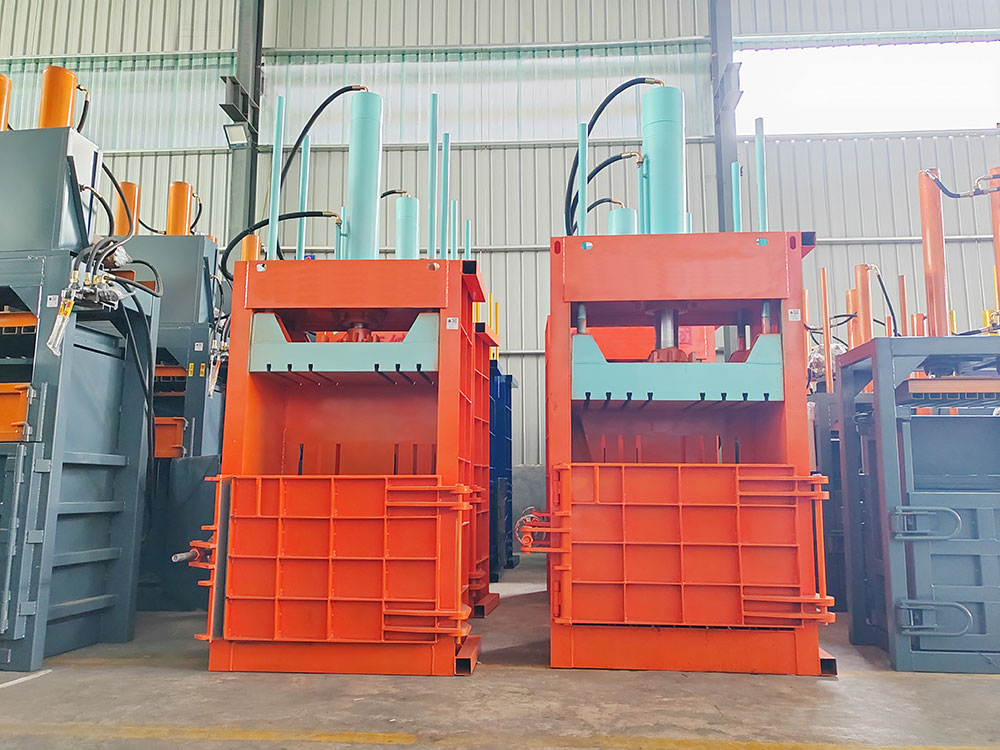Dealing with bulky textiles eats storage and raises costs. Frustration mounts when waste piles up daily. Our hydraulic balers compress it fast into manageable bales.
Vertical balers compact textile waste significantly by applying hydraulic pressure to materials, reducing volume up to 90%. This maximizes storage, lowers transport costs, and prepares waste for recycling, offering immediate business savings.

Waste disposal shouldn’t slow your operations. Let’s explore specific solutions.
Why Choose Vertical Balers for Clothing Recycling?
Piles of unsold garments clog warehouses. Disposal costs balloon endlessly. We compress them into dense blocks effortlessly.
Vertical balers recycle clothing by compressing tons of textiles into compact bales. This creates market-ready recyclables and saves over 80% in disposal costs, boosting sustainability and profits directly.
Key Benefits in Textile Recycling
Textile recycling faces unique hurdles. Vertical balers provide tailored answers.
Here’s how they solve common issues:
| Problem | Solution with Vertical Balers | Business Impact |
|---|---|---|
| Bulk storage | Reduce volume by 10:1 | Halve warehouse costs |
| Transport losses | Secure bales with auto-tying | Prevent spillage fees |
| Slow processing | Achieve 3-5 cycles/hour | Double handling capacity |
Customization for Fabric Types
Different textiles react differently:
- Knitted fabrics: Require adjustable pressure
- Denim: Needs higher compression force
- Thin synthetics: Benefit from slower ram speeds
We adjust motors and platen shapes to match. For example, our adjustable pressure valve works great for delicate blends.
"After switching to ShunYin’s system, our recycling efficiency jumped by 70%." – Apparel client in Canada
Ready to test with your garments? Send fabric samples via WhatsApp for a compression analysis.
How to Maximize Fabric Waste Value?
Fabric scraps accumulate unpredictably. Sorting takes hours before disposal. Our solutions turn this mess into profit.
Vertical balers handle fabric scraps through customized chambers that compress mixed materials evenly. This creates uniform bales for resale, generating new revenue while eliminating sorting labor instantly.

Optimizing Fabric Scrap Processing
Not all scraps behave the same way. Here’s our approach:
Material Density Guide
Denser textiles demand stronger compression:
| Fabric Type | Recommended Force (tons) | Bale Density (kg/m³) |
|---|---|---|
| Cotton cuttings | 20-30 | 350-450 |
| Polyester blends | 40-50 | 500-650 |
| Mixed synthetic scraps | 60+ | 700-850 |
Higher density means more value per bale. Our team configures the hydraulic system according to your waste profile.
Preventing Operational Delays
Three common issues:
- Jamming: We add V-shaped ram designs to deflect threads
- Inconsistent bales: Install pressure sensors for uniformity
- Contamination: Include removable trays for residual liquids
For facilities handling oily textiles, we integrate stainless steel components at no extra cost. Ask about our chemical-resistance options today.
Can Foam Waste Be Baled Effectively?
Mattress foams sprawl in warehouses. Handling feels like fighting air. Vertical balers conquer this challenge easily.
Vertical balers compress foam waste using slow-compression cycles and high holding force. This prevents material rebound and achieves 15:1 volume reduction, cutting storage needs dramatically.
Engineering for Elastic Materials
Foam presents physics challenges:
- Rebound effect: Material expands post-compression
- Low bulk density: Needs intense pressure
- Irregular shapes: Requires precise chamber design
Side-by-Side Compression Comparison
Why standard balers often fail:
| Parameter | Standard Baler | ShunYin Foam Optimized |
|---|---|---|
| Cycle time | Fast (30 sec) | Slow (90 sec) |
| Holding pressure | Low | Ultra-high |
| Compression ratio | 6:1 | 15:1 |
| Bale stability | Poor | Excellent |
We extend compression time and boost force by 45%. A foam factory in Singapore reduced waste costs by 60% with our tech. Want similar results? Share your foam types via WhatsApp.
What Makes Rags Ideal for Vertical Baling?
Greasy workshop rags create fire hazards and disposal headaches. They pile up faster than cleanup crews handle.
Vertical balers manage rags through sealed chambers and optional leak trays. This contains oils safely, reduces fire risks, and creates transport-ready bales with zero fluid seepage.

Safety and Efficiency Solutions
Oily rags demand special considerations:
Hazard Mitigation Features
Built-in protections lower risks:
| Safety Challenge | Our Solution | Added Benefit |
|---|---|---|
| Oil drips | Drip pans under chamber | Avoid soil contamination |
| Combustion risk | Optional explosion-proof motors | Meet workshop safety codes |
| Toxic residue | Easy-clean removable liners | 5-minute washout during shifts |
Operational tips improve outcomes:
- Pre-sorting: Remove metal components first
- Moisture control: Configure pressure for wet batches
- Bale wrapping: Use self-adhesive films to seal oils
Japanese clients upgraded their rag handling after visiting our factory near Shanghai. Custom specs for oily materials? Our engineers advise via WhatsApp anytime.
Conclusion
Vertical balers convert textile waste from costly burdens into recyclable assets efficiently. Start your waste transformation today.








